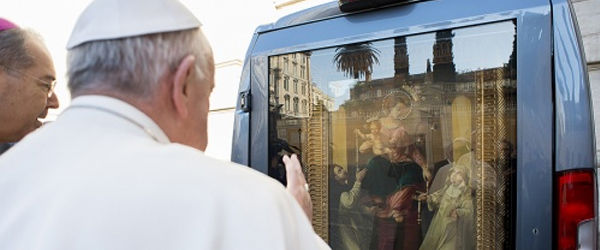Pierre Teilhard de Chardin, in one of his dialogues with the Congregation for the Doctrine of the Faith in Rome, was once asked: "What are you trying to do?" His answer was something to this effect: “I'm trying to write a Christology that is large enough to include the full Christ because Christ isn't just a divine savior sent to save people; Christ is also a structure within the physical universe, a path of salvation for the earth itself.” What is meant by this? How is Christ a structure within physical creation? Perhaps the most neglected part of our understanding of Christ, though clearly taught in Scripture, is the concept that the mystery of Christ is larger than what we see visibly in the life of Jesus and in the life of the historical Christian churches. Christ is already part of physical creation itself and is integral to that creation. We see this expressed, for example, in the Epistle to the Colossians. Describing the reality of Christ, the author writes: “He is the image of the invisible God, the first-born of all creation, for in him all things were created in heaven and on earth; everything visible and everything invisible ... all things were created through him and for him. He exists before all things and in him all things hold together” (Colossians 1: 15-18). As well, in the Epistle to the Romans, St. Paul tells us that just as human persons groan within our mortal limits and ache for immortality, so too does all of physical creation. The earth too longs for salvation. And the mystery of Christ is its path to immortality, just as it is our path to that same end.
The mystery of Christ is not just about saving us, the people on this planet; it is also about saving the planet itself.
The mystery of Christ is wider, deeper and more encompassing than what can be seen simply within the visible life of Jesus and the visible history of the Christian churches. Granted, what we see visibly in the life of Jesus and the history of the Christian churches is something very precious and very privileged. The Christian churches are (like Mary, the Mother of Jesus) the place where God visibly, concretely, tangibly and historically enters this world. But, as Scripture and Christian theology affirm, the mystery of Christ is more encompassing than what we can see visibly and historically. It also includes what the Epistle to the Colossians teaches, namely, that physical creation itself was somehow created through Christ, that Christ is what holds it together, and that Christ is what gives it an eternal future. The mystery of Christ is not just about saving us, the people on this planet; it is also about saving the planet itself. Incorporating this into our understanding has huge consequences both in how we understand our planet, earth, and how we understand other religions. If all things were created through Christ and for Christ, then our planet, Earth, and all of physical creation have value in themselves and not just in relation to us. The earth too is God's child, not self-conscious as we are, but with its own proper rights and right to respect. Simply put, the earth is not just a stage for us to play on. It too is part of the mystery of Christ and the mystery of salvation. We must respect it for its own sake, and not just because our health depends upon its health. The deep roots for any eco-theology lie deeper than in the practical concern for a continued supply of healthy air, water and food. Nature too is inside the mystery of Christ. There are huge implications from this for how we view other religions. As Christians, we must take seriously Jesus' teaching that Christ is the (only) way to salvation and that nobody goes to the Father except through Christ. So where does that leave non-Christians and other persons of sincere heart, given that at any given time two-thirds of the world is not relating to the historical Jesus or the Christian churches? Unless we understand the mystery of Christ as deeper and wider than what we can see visibly and historically, this quandary will invariably lead us to either abandon Jesus' teaching about being normative or lead us into an exclusivity that goes against God's universal will for salvation. If, by the mystery of Christ, we mean only the visible Jesus and the visible church, then we are caught in a dilemma with no answer. If, however, by the mystery of Christ, we also mean the mystery of God becoming incarnate inside of physical creation, beginning already in the original creation, continuing there as the soul that binds the whole of physical creation together, and being there as both the energy that lures creation towards its Creator and the consummation of that creation, then all things have to do with Christ, whether they realize it or not, and all authentic worship leads to the Father, whether we can see this or not. In the words of Kenneth Cragg: It takes a whole world to understand a whole Christ. Oblate of Mary Immaculate Father Ronald Rolheiser is a specialist in the field of spirituality and systematic theology. His website is www.ronrolheiser.com.

